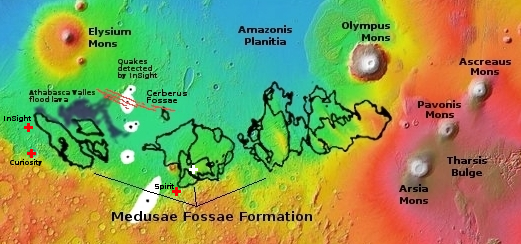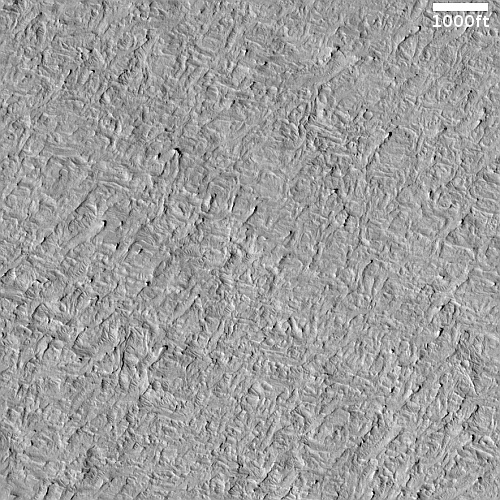The featureless volcanic ash plains of Mars
Cool image time! The photo to the right, cropped, reduced, and sharpened to post here, was taken on September 10, 2022 by the high resolution camera on Mars Reconnaissance Orbiter (MRO). It shows what appears to be a relatively featureless plain with a surface resembling stucco.
At -9 degrees south latitude, this is in the Martian dry equatorial regions. No ice or glaciers here. However, the consistent orientation of the knobs and hills suggest dunes and sand blown by prevailing winds, and that guess holds some truth. This location is deep within the Medusae Fossae Formation, the largest volcanic ash deposit on Mars, covering an area about as big as India, and believed to be the source of most of the red planet’s dust.
We are thus looking at thick layer of ash, its surface shaped over eons by the winds of Mars’ thin atmosphere.

The white cross on the overview map to the right marks the location of this picture, about 250 miles north of where the rover Spirit had roamed.
A look at a wider MRO context camera image of this area only shows that this featureless terrain extends over a wide area. Traveling here would not only be difficult, but there would be few clear features to guide you. Getting lost without GPS would be very easy.
The full high resolution image however reveals that the orientation of the stucco terrain shifts suddenly by 90 degrees to the south, while to the north the knobs and dunelike features almost vanish entirely, leaving the ground relatively smooth and even more featureless. Why the ash field should change like this is a complete puzzle. Maybe some of what we are looking at is not ash but frozen lava. Maybe. I am guessing.
On Christmas Eve 1968 three Americans became the first humans to visit another world. What they did to celebrate was unexpected and profound, and will be remembered throughout all human history. Genesis: the Story of Apollo 8, Robert Zimmerman's classic history of humanity's first journey to another world, tells that story, and it is now available as both an ebook and an audiobook, both with a foreword by Valerie Anders and a new introduction by Robert Zimmerman.
The print edition can be purchased at Amazon or from any other book seller. If you want an autographed copy the price is $60 for the hardback and $45 for the paperback, plus $8 shipping for each. Go here for purchasing details. The ebook is available everywhere for $5.99 (before discount) at amazon, or direct from my ebook publisher, ebookit. If you buy it from ebookit you don't support the big tech companies and the author gets a bigger cut much sooner.
The audiobook is also available at all these vendors, and is also free with a 30-day trial membership to Audible.
"Not simply about one mission, [Genesis] is also the history of America's quest for the moon... Zimmerman has done a masterful job of tying disparate events together into a solid account of one of America's greatest human triumphs."--San Antonio Express-News
Cool image time! The photo to the right, cropped, reduced, and sharpened to post here, was taken on September 10, 2022 by the high resolution camera on Mars Reconnaissance Orbiter (MRO). It shows what appears to be a relatively featureless plain with a surface resembling stucco.
At -9 degrees south latitude, this is in the Martian dry equatorial regions. No ice or glaciers here. However, the consistent orientation of the knobs and hills suggest dunes and sand blown by prevailing winds, and that guess holds some truth. This location is deep within the Medusae Fossae Formation, the largest volcanic ash deposit on Mars, covering an area about as big as India, and believed to be the source of most of the red planet’s dust.
We are thus looking at thick layer of ash, its surface shaped over eons by the winds of Mars’ thin atmosphere.

The white cross on the overview map to the right marks the location of this picture, about 250 miles north of where the rover Spirit had roamed.
A look at a wider MRO context camera image of this area only shows that this featureless terrain extends over a wide area. Traveling here would not only be difficult, but there would be few clear features to guide you. Getting lost without GPS would be very easy.
The full high resolution image however reveals that the orientation of the stucco terrain shifts suddenly by 90 degrees to the south, while to the north the knobs and dunelike features almost vanish entirely, leaving the ground relatively smooth and even more featureless. Why the ash field should change like this is a complete puzzle. Maybe some of what we are looking at is not ash but frozen lava. Maybe. I am guessing.
On Christmas Eve 1968 three Americans became the first humans to visit another world. What they did to celebrate was unexpected and profound, and will be remembered throughout all human history. Genesis: the Story of Apollo 8, Robert Zimmerman's classic history of humanity's first journey to another world, tells that story, and it is now available as both an ebook and an audiobook, both with a foreword by Valerie Anders and a new introduction by Robert Zimmerman.
The print edition can be purchased at Amazon or from any other book seller. If you want an autographed copy the price is $60 for the hardback and $45 for the paperback, plus $8 shipping for each. Go here for purchasing details. The ebook is available everywhere for $5.99 (before discount) at amazon, or direct from my ebook publisher, ebookit. If you buy it from ebookit you don't support the big tech companies and the author gets a bigger cut much sooner.
The audiobook is also available at all these vendors, and is also free with a 30-day trial membership to Audible.
"Not simply about one mission, [Genesis] is also the history of America's quest for the moon... Zimmerman has done a masterful job of tying disparate events together into a solid account of one of America's greatest human triumphs."--San Antonio Express-News



Is it possible that the oblique terrain is a younger flow channeled by the terrain to the North? It appears that terrain is in the last stages of losing a geological layer, judging by the relatively small size and large number of the buttes.